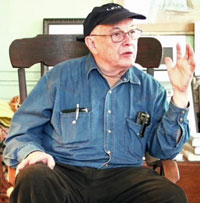Renowned photographer Bruce Davidson talks about his life as a photojournalist in Leica video
posted Wednesday, August 8, 2012 at 12:30 PM EDT
 Bruce Davidson is one of my photographic heroes and watching “Bruce Davidson, A Lifetime With Leica” (see video posted below) is a quiet joy. It is only a few minutes long but it is worth viewing for both his insights into photojournalism, and his powerful photographs.
Bruce Davidson is one of my photographic heroes and watching “Bruce Davidson, A Lifetime With Leica” (see video posted below) is a quiet joy. It is only a few minutes long but it is worth viewing for both his insights into photojournalism, and his powerful photographs.
In the video, Davidson begins by explaining that what is most important for good photojournalism is time.
“It takes a long time to enter someone else’s life,” he notes.
Like W. Eugene Smith, Robert Doisneau, or Henri Cartier-Bresson, Davidson is from a generation of photographers whose stories could take months or even years to complete, a far cry from today’s instant journalism.
Born in 1933 in Oak Park, Illinois, he grew up the only child of a single working mother. Luckily, she had the foresight to recognize her son’s interest in photography and build him a darkroom in their basement. Soon Bruce was winning prizes for his photography.
After high school, he went on to study at the Rochester Institute of Technology and then Yale. Following a stint in the Army, in 1958, he joined Magnum Photo Agency and has been freelancing ever since.
In the early 1960s, he photographed the Civil Rights movement. He recalls that he was “naïve to think that a white boy from the Midwest” could simply arrive in the South and start taking pictures.
However, he persisted and after a few years was accepted by the movement. Persistence, he points out, is another skill that photojournalists require and he bemoans that, “Today, young people (photographers) stop too soon.”
Davidson’s most famous work is East 100th Street, a book that deeply affected me, and how I take photographs. Focused on a street in New York City’s (then) black Harlem, Davidson spent years photographing the ordinary -- yet extraordinary -- lives of the people who lived on just one block.
After a lot of persistence, he won the neighborhood’s trust, and could photograph freely. The resulting images are intimate -- sometimes brutal -- close-ups of the daily struggle with violence and poverty, however these images reveal more than that.
It is something I learned, long ago, from Davidson’s work. It shines through in his images (and in this video, which is otherwise a bit of an ad for Leica). It is the need for compassion. In books like East 100th Street, The Dwarf and Subway, Davidson records more than the tragedies of lives; he documents the resilience of people and their hopes in the face of unimaginable hardships.
Davidson’s photographs also speak to another aspect of photojournalism. As Davidson once said: "If I am looking for a story at all, it is in my relationship to the subject - the story that tells me, rather than that I tell."